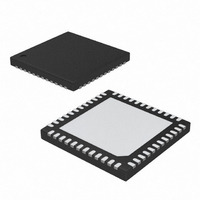MAX9851ETM+ Maxim Integrated Products, MAX9851ETM+ Datasheet - Page 37

MAX9851ETM+
Manufacturer Part Number
MAX9851ETM+
Description
IC CODEC AUDIO STEREO 48TQFN-EP
Manufacturer
Maxim Integrated Products
Type
Stereo Audior
Datasheet
1.MAX9851ETM.pdf
(71 pages)
Specifications of MAX9851ETM+
Data Interface
Serial
Resolution (bits)
18 b
Number Of Adcs / Dacs
2 / 2
Sigma Delta
Yes
S/n Ratio, Adcs / Dacs (db) Typ
81.5 / 88
Dynamic Range, Adcs / Dacs (db) Typ
82 / 87.5
Voltage - Supply, Analog
2.6 V ~ 3.3 V
Voltage - Supply, Digital
1.7 V ~ 3.3 V
Operating Temperature
-40°C ~ 85°C
Mounting Type
Surface Mount
Package / Case
48-TQFN Exposed Pad
Number Of Adc Inputs
3
Number Of Dac Outputs
3
Conversion Rate
48 KSPS
Interface Type
Serial (2-Wire, 3-Wire, I2C)
Resolution
18 bit
Operating Supply Voltage
1.7 V to 3.3 V
Maximum Operating Temperature
+ 85 C
Mounting Style
SMD/SMT
Minimum Operating Temperature
- 40 C
Number Of Channels
2 ADC/2 DAC
Supply Current
6.2 mA
Thd Plus Noise
- 84 .5 dB
Lead Free Status / RoHS Status
Lead free / RoHS Compliant
inductance of the speaker coil to filter the high-frequen-
cy PWM components, and the natural filtering of both
the speaker and the human ear to recover the audio
component of the square-wave output. Eliminating the
output filter results in a smaller, less costly, and more
efficient solution. Because the switching frequency of
the MAX9851 output is well beyond the bandwidth of
cell-phone speakers, voice coil movement due to the
square-wave frequency is negligible.
The MAX9853 features a pair of differential line outputs
instead of the Class D speaker amplifiers of the
MAX9851. Set LOMODE to 11 (register 0x18, bits B4
and B3) to enable the stereo line outputs of the
MAX9853. The line outputs can be used simultaneously
with the headphone or receiver amplifier for maximum
flexibility in driving an external audio amplifier or other
analog audio IC. The line outputs feature gain
adjustable between +7.1dB and -72.4dB. Program the
gain of the line outputs with LOPGAL and LOPGAR
(registers 0x16 and 0x17, bits B5 to B0).
Shutdown output and fault input pins are available for
interfacing with an external speaker amplifier IC. The
open-drain shutdown output can be used to control an
external amplifier through the MAX9853 I
The fault logic input has an internal 300kΩ pullup resis-
tor which can be reported in the I
trigger the interrupt output.
The MAX9851/MAX9853 feature volume control ampli-
fiers on the headphone, receiver, speaker (MAX9851
only), and line (MAX9853 only) outputs that can be con-
trolled through the I
rate volume control amplifiers for left and right in addition
to a mute feature. Set VSEN to 1 (register 0x18, bit B6) to
enable volume change smoothing. Enabling this feature
gives a smooth-sounding gain change by stepping
through all intermediate settings at a 2ms rate per step
when a volume or mute change occurs.
Set ZDEN to 1 (register 0x18, bit B5) to enable the zero-
crossing detection feature. This causes volume and mute
changes to occur only at zero-crossings of the audio
waveform and reduces objectionable clicks or “zipper
noise” that can occur while making volume changes.
Once the part is initialized, the MCLK is not required
during modes where the ADC and DAC are disabled
Stereo Audio CODECs with Microphone, DirectDrive
Differential Line Outputs (MAX9853 Only)
Headphones, Speaker Amplifiers, or Line Outputs
______________________________________________________________________________________
2
Shutdown Output and Fault Input
C interface. Each output has sepa-
2
C status register and
Volume Control
2
C interface.
(for instance, playing line inputs through the head-
phone outputs). However, the part needs MCLK to be
applied for a short period of time (> 1ms) after power-
on to initialize volume control circuitry—this is only once
per power-on.
Two microphone interfaces allow the MAX9851/
MAX9853 to accommodate inputs from both an internal
handset microphone and external headset micro-
phones. Both inputs feature 0 to +20dB of gain selec-
table in 1dB increments with an additional 20dB of gain
selectable to increase the range from 0 to +40dB,
accommodating a wide range of microphones.
Set MEXT to 0 (register 0x12, bit B2) to select the inter-
nal microphone input, featuring a differential input to
minimize noise pickup. A low-noise bias voltage
(INTMICBIAS) is available to bias the microphone from
a clean supply. The mono input signal is treated as a
left microphone signal by MAX9851/MAX9853 internal
circuitry. Bypass INTMICBIAS to GND with a 1µF
capacitor.
Set MEXT to 1 to select the external microphone input
featuring stereo single-ended inputs with a separate
ground to reduce noise pickup. Connect the external
microphones to EXTMICBIASL and EXTMICBIASR to
provide a bias voltage for the microphones. Set RBIAS to
0 (register 0x12, bit B0) to select an output impedance of
2.2kΩ for the independent low-noise bias pins.
Alternatively, set RBIAS to 1 to select an output imped-
ance of 470Ω. A microphone bias voltage of +2.4V, gen-
erated from INTMICBIAS, is used for both resistor
settings. The selectable bias resistors allow extra flexibili-
ty in selecting microphones without requiring external
resistors to bias the microphones. The 470Ω impedance
can be chosen when using an external RC filter near the
headset jack. The external biases are high impedance
when disabled, even in the presence of an applied volt-
age up to AV
An internally routed sidetone signal is available to allow
analog routing of the left microphone signal. The
sidetone input is the output of the left microphone gain
amplifier. This sidetone signal has an independent gain
adjustment from -32dB to +30dB. The sidetone signal
is available as an input to both the left and right analog
output mixer (see the Signal Routing section).
DD
.
Microphone Amplifiers
Sidetone
37











